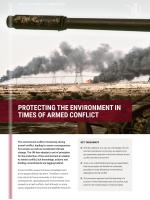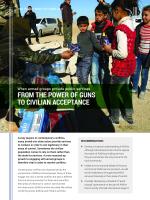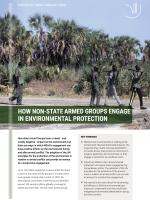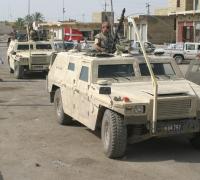How non-state armed groups engage in environmental protection
- NSAGs have mixed records of relating to the environment. Beyond detrimental impacts, the insecurity they create can keep exploitation of forests at bay; they protect environment to enhance legitimacy and recruitment; or they engage in protection as a political vision.
- Enhancing NSAGs role in environmental protection will require future engagement by humanitarian actors. The adoption of the UN principles for the protection of the environment in relation to armed conflict can provide an avenue for constructive engagement.
- We need to know more about the functioning and efficacy of NSAGs environmental governance to understand how they could help mitigating environmental deterioration during and after conflict.
Up to 160 million people live in areas under the direct control of non-state armed groups or in areas where such groups contest state control. In 2020, the International Committee of the Red Cross identified around 100 armed conflicts globally, involving 60 states and more than 100 non-state armed groups.
The toll of violent conflict is cumulative: new ones appear faster than old ones are resolved. These conflicts are part of complex emergencies, fueling and being fueled by stress on natural resources reinforced by climate change and environmental degradation; poverty; and lack of environmental regulation.
It is not unusual that international organizations and NGOs engage with NSAGs for humanitarian reasons, holding them accountable according to International Humanitarian Law (IHL). But environmental concerns do not rank high when engaging these groups. IHL does include obligations related to the environment for NSAGs that control territory and hold de facto authority, but observers argue that IHL is too anthropocentric. While the focus on human protection is understandable, the importance of the environment is underestimated. Academic Hugo Slim, for instance, argues that it is important that ”we increasingly place human need in the wider context of ecological ethics.”
Drawing on additional international laws linked to human rights and the environment, the newly adopted “UN Guidelines for the Protection of the Environment in Relation to Armed Conflict” (PERAC) seek to make up for the low priority previously given to the environment. They provide a new basis for engaging NSAGs regarding their impact on the environment during and after armed conflict.
How NSAGs protect the environment
To engage NSAGs over environmental issues, it is necessary to map and understand their varying roles and impact in different contexts. So far, the focus of attention has been on the negative effects on the environment. Like other military forces, NSAG’s are often involved in actions that deteriorate the environment, from the unregulated exploitation of timber, charcoal, coltan, and other minerals, to finance warfare, to the burning of oil wells and chemical plants to destroy government assets, as it happened during IS’s retreat in Iraq.
While the focus on human protection in international humanitarian law is understandable, the importance of the environment is underestimated
Our survey of 20 NSAGs operating in Afghanistan, Colombia, Ethiopia, Iraq, Mali, Myanmar, Somalia and Syria shows that NSAG’s have mixed and mostly negative records in terms of their environmental impact, but we have identified three ways in which NSAG’s engagement can have positive effects on the environment during and after armed conflict:
- Unintended forest protection
Known as ‘conservation at gunpoint’, the activities of NSAGs can unintentionally reduce pressure on forest resources by making large areas inaccessible to national armies, settlers, or extraction companies. Since the forest provides cover for insurgent forces, NSAGs like the Revolutionary Armed Forces of Colombia (FARC) created institutions for controlling land-use and enforcing limits to cultivation, crude oil exploitation, and fishery with explosives. Similarly, several Islamist NSAGs, such as the ones operating in Mali/Sahel, have followed the advice of Bin Laden to protect vegetation and support reforestation to provide cover for their armed forces.
- Environmental protection for recruitment and legitimacy
A handful of NSAGs in the survey have included provisions for environmental protection during armed conflict in their doctrines. These comprise for example the Kurdish Workers Party (PKK) in Turkey and Iraq, and the Chin National Front (CNF) in Myanmar who all seek, where possible, to avoid using weapons or actions that can damage the environment, thus respecting the principle of proportionality in IHL.
Islamist NSAGs that operate among populations in environments that are vulnerable to climate change and desertification, use environmentalism for recruitment and for gaining legitimacy vis á vis passive states. They blame the West for environmental degradation and showcase reforestation programs (e.g Taliban). In Somalia, al-Shabaab introduced a ban on plastic bags, which are very harmful to livestock in al-Shabaab’s pastoral areas of support.
- Environmental protection as political vision
In our sample, three NSAGs have developed political visions that center on environmental protection. The Karen National Union (KNU), Myanmar’s oldest ‘ethnic armed organization’, has a long experience in natural resource management, with its own land, forestry and environmental policies and departments, including the creation of a large, protected area. Working with civil society organizations and communities, the environmental protection activities of the KNU are based on customary practices and linked to the idea of indigenous sovereignty in KNU-controlled territory. They also have a rare history of engagement with international NGO’s such as the Worldwide Fund for Nature (WWF), which, before the 2021 military coup, sought to mediate between KNU and the Myanmar government for the support of wildlife conservation in forested areas under mixed government/KNU control.
In the Kurdish Autonomous Administration of North-East Syria (AANES or Rojava), the People’s Protection Unit (YPG) - the military wing of the Democratic Union Party (PYD) - promotes an “eco-socialist” project based on self-governing farming collectives. This is a political as much as a military project. It is inscribed in the “Charter of the Social Contract” about self-rule in Rojava, where the preservation of the environment is presented as a “moral and sacred national duty.” Again, protection of the environment is linked to the idea of “national” (Kurdish) sovereignty on land (re-)appropriated from the Syrian government.
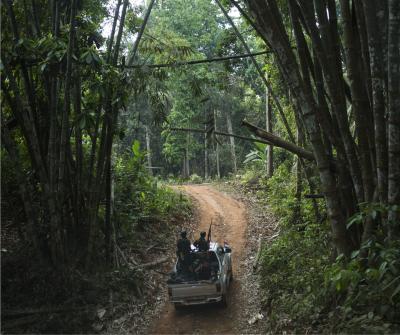
Also, the Ogaden National Liberation Front (ONLF), which until the peace accords in 2018 fought for self-determination for the Somali-dominated region of Ethiopia, had a strong, ideological approach towards environmental protection. Linking this to the quest for self-determination of the largely pastoral population, ONLF resisted oil exploitation and other ‘intrusions’ that harmed grazing lands. As their program says, “Recognizing that the colonizer implements policies in Ogaden without regard to environmental impact, the ONLF affirm that we shall confront all initiatives, which negatively impact our environment as a matter of national duty to protect our environment for future generations.”
Looking Ahead
Too little is still known about how NSAGs in different contexts relate to the environment, but while some have internal directives protecting the environment, others place the environment centrally in their political visions. Given the effects of climate change and environmental degradation, the importance of ideologies and politics that include or build on environmental concerns are likely to increase. There is scope for international engagement with NSAGs about environmental concerns, and the new UN Principles for the Protection of the Environment in Relation to Armed Conflict provide a framework for such engagement. Previous humanitarian engagement with NSAGs show that they can be engaged around the adoption of international norms, like the ban on landmines. States are unwilling to sign treaties with NSAGs because it suggests recognition, but there is good experience with unilateral declarations by NSAGs. More knowledge about these organizations will help develop the international engagement around environmental issues during and after armed conflict.
This publication is part of the Defence and Security Studies at DIIS, written by Jairo Munive, independent researcher (Munive.jairo@gmail.com) and Finn Stepputat Senior Researcher DIIS (fst@diis.dk)
DIIS Eksperter

